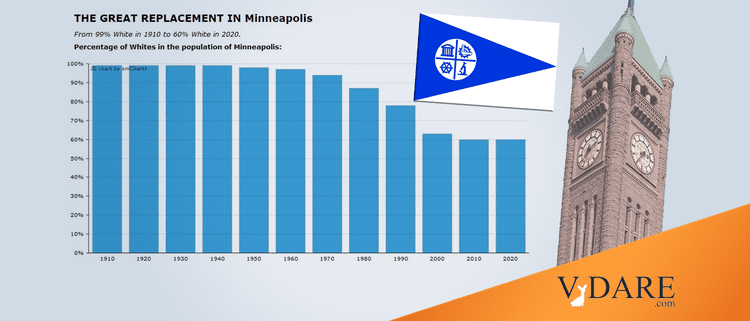Why take just a macro-look at The Great Replacement in the United States of America, when you can easily take a micro-look? Let’s take a look at Minneapolis, MN. For those wondering, here’s the racial breakdown of Minneapolis from 1910–2020:
Here’s more:
Minneapolis, Minnesota, was almost entirely white until 1980. However, in the last few decades, large numbers of non-whites came to the city, especially immigrants from Somalia. Now, the idyllic city created by settlers and pioneers is a center for black crime and Islamic terrorist recruitment.
The city’s story began when the United States Army built Fort Snelling after the War of 1812 to guard American settlers. The most famous non-white inhabitant of Fort Snelling was Dred Scott, whose efforts to escape slavery led to the Supreme Court’s ruling in Dred Scott v. Sandford. Chief Justice Roger Taney wrote that blacks were not citizens and “are not included, and were not intended to be included, under the world ‘citizens’ in the Constitution, and can therefore claim none of rights and privileges which that instrument provides for and secures to citizens of the United States.”
After more settlers came, several local settlements combined. Adolf Hoeffler, a German who visited the area in 1852, predicted it would eventually become “an extensive manufacturing town, and depot of all the future productions of the extreme Upper Mississippi.” Minneapolis was ideally placed for milling flour, not just manufacturing. Its name means “water city.” From 1870 to 1890, Minneapolis grew from 13,000 people to almost 165,000. Almost everyone was white.
Many city leaders wanted to keep it that way. “Restrictive covenants” to keep neighborhoods white were used from 1910 until 1950. The fascist Silver Legion or “Silver Shirts” had a presence in the city in the 1930s. Blacks were simply not a significant presence in the city for most of its history, so ethnic tension was between Jews and gentiles, not blacks and whites. Some help-wanted ads even said, “Gentile preferred.” Minneapolis was a critical battleground for the Progressive movement. The Minnesota Farmer-Labor Party didn’t unite with the Democrats until 1944, and the quasi-socialist MFLP was able to elect candidates such as Minneapolis mayor Thomas Latimer. Class and ideology — not race — dominated city politics.
Non-whites started coming to the city in large numbers in the 1970s and 1980s. By 1990, the city was more than 20 percent non-white. Some migrants may have been tempted by Minnesota’s generous welfare programs. However, there was also a deliberate effort by churches and refugee settlement organizations to bring them. Corporations also wanted cheap labor, such as the meat packers who hired Somalis. [The Great Replacement: Minneapolis, AmRen.com, Gregory Hood and Paul Kersey, May 11, 2020]
The Great Replacement is no myth. It’s happened in Minneapolis, where the white population dropped from 99% in 1910 to 60% white today. You could even say it’s state policy to change the racial demographics of the city via refugee resettlement (a nicer word for white displacement).
Odds are, it’s coming to a city near you.
[Comment at Unz.com]













